Now & New
- Explore
One if by Land, Three if by Sea, Part Three: The Artwork That Is Setoda
Active tourists from the four corners of the world come to Hiroshima just for the Shimanami Kaido, a road that runs across several Setouchi islands, linking Onomichi in Hiroshima Prefecture with Imabari in Ehime Prefecture. This road can be crossed by automobile, motorcycle, motor scooter, bicycle, and even on foot, but tackling this course by bike seems to be the most popular and recommended option. The Shimanami Kaido could very well be done in a single day, but those who try to speed through the Shimanami Kaido end up missing the opportunity to appreciate the beauty of every island they set foot on, and is travel not all about the stops along the way to the goal? There are six islands that travelers pass through while attempting the Shimanami Kaido challenge, and while each island has its appeal, the island with the most tourist sites—and consequently, the most tourists—would probably be Ikuchijima, especially the area around Setoda Port.
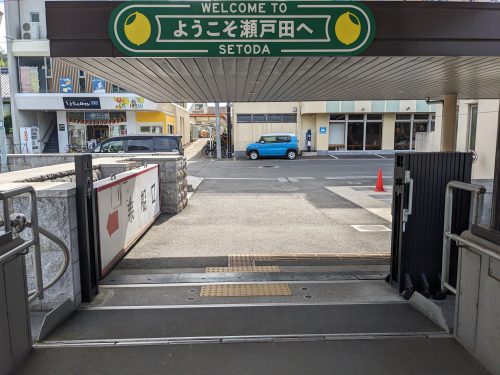
Visitors who don’t want to bother biking all the way to Ikuchijima—the third island when starting from Onomichi—have the option of taking a ferry from Onomichi Port straight to Setoda, but thankfully, there is also a ferry line to Setoda that departs from Mihara Port. Setoda Port is a locale rife with quaint shops, museums, ryokan, et cetera, so I knew I could spend most of my day on this island, as opposed to constantly being on the move the day before. The two most famous sites on Ikuchijima—both being in close proximity to each other—are Kosanji (a temple with an adjacent museum) and the Ikuo Hirayama Museum of Art, but I decided out the latter since I had been to Kosanji before, and I wanted to concentrate on exploring one museum at a leisurely pace.
Hirayama’s Masterpieces
The Ikuo Hirayama Museum of Art is dedicated to the Nihonga (日本画 – Japanese-style painting) painter Ikuo Hirayama, who was born in Setoda and survived the atomic bombing of August 6th, 1945. As we witnessed the blast and its effects with his own eyes, he naturally turned those memories into paintings, but also painted more serene landscapes of famous sites in Hiroshima Prefecture. Some authentic works by Hirayama himself were for sale right next to the museum gift shop, though they would set buyers back a few hundred thousand yen. As one passerby commented when he saw the price tag on one of the pictures, “you can buy a car with that kind of money and visit dozens of other art museums.”
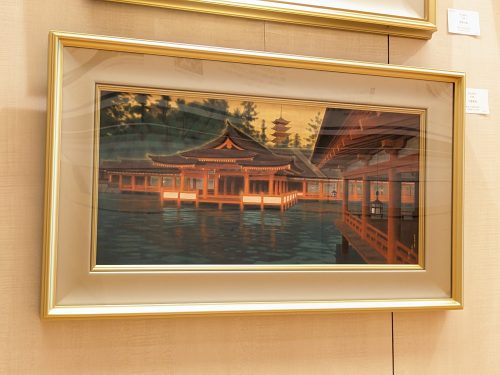
Another common theme among Mr. Hirayama’s works is his fascination with locations along the Silk Road, especially landscapes in Northwest China, Iran, and Iraq. These pictures fantastically depict a fraction of the story of exchange between Japan and the rest of Asia, including the transmission of Buddhism to Japan. The museum had numerous rooms where one could catch a glimpse of the everyday comings and goings of these nomadic traders, with lots of space and seats in between for taking a break.
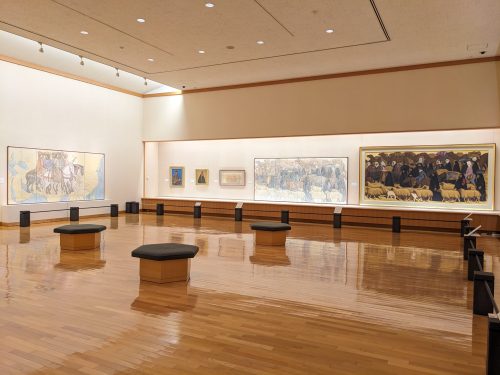
Some of these paintings are rather ginormous, and one of my personal favorites is this one of the Kurushima Ohashi, a draconian bridge on the Shimanami Kaido linking Oshima (the final island when traveling from Onomichi) to Imabari on Shikoku. The sheer scale of this bridge is both daunting and inspiring at the same time, as it emanates this “final boss” feel to remind cyclists what they’re up against, yet prophesizes the treasure of a vista that awaits those who tough it out. As someone who has extensively traveled Hiroshima Prefecture, there’s no better feeling of seeing a painting or photograph on exhibition of a place I had conquered in the past, and being able to puff out my chest as I exclaim, “I was there.”
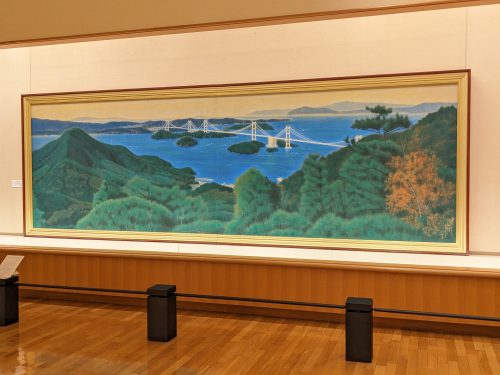
Outside of the main exhibition halls, there were other noteworthy things to see that can increase a visitor’s knowledge on the subject of fine arts or Ikuo Hirayama. One example is this glass case full of minerals that are the source for a variety of colors in Nihonga. Obviously, gold leaf is used to color things gold, but it was enriching to learn the names of the stones that make the other pigments, such as jasper for brown, malachite for green, and azurite or lapis lazuli for ultramarine.
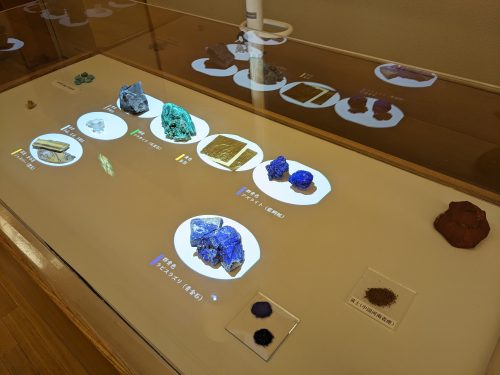
Opposite the wall where the paintings were being sold was a theater room, showing three different short films that alternated every few minutes. They all explained Hirayama’s works in extensive detail, but each movie covered different pieces and focused on diverse, appealing aspects found within individual pictures. It was amusing to walk out of that theater after watching all three films, and seeing some of the same paintings featured on screen hung on the wall for sale. I guess that’s one way to convince some wealthy connoisseurs to buy the late Hirayama’s paintings in order to further support the museum.
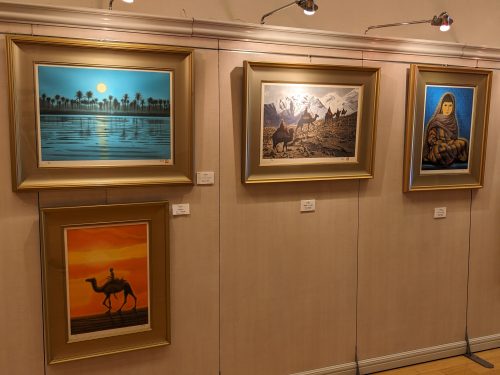
I saw many astounding masterpieces that morning, but the most impressive item in the entire museum would have to be the Super Clone chamber, which replicates Cave #57 of the Mogao Caves in Dunhuang, a city in China’s northwesterly Gansu Province. According to the information I obtained (in English, no less) by scanning the nearby QR Code, the Super Clone project was born out of the conundrum of preservation versus disclosure of ancient ruins. If tourists start visiting these isolated caves, they deteriorate in quality, but if they are closed to the public, the purpose of preservation is lost when people cannot appreciate the aesthetics.
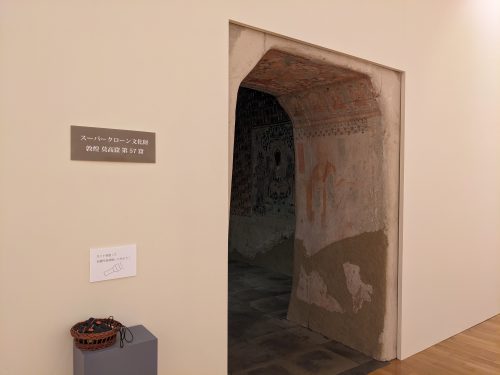
With a Super Clone copy of this cave, visitors get a hands-on experience while learning about an ancient Buddhist site. Miniature flashlights are available just outside the entrance, letting everyone pretend to be an archaeologist just for a while. I’m certain that if Mr. Hirayama were alive today to experience this Super Clone technology for himself, he’d be as jubilant as a juvenile on a junior high school field trip!
Shiomachi Gourmet
I managed to stay in the museum until noon, at which point my grumpy tummy was begging me to nab some lunch. The museum has a café and souvenir foods for sale, but it’s mostly coffee and cake, so I would have to take my meal elsewhere. Restaurants are littered all over Ikuchijima, but the number one destination when searching for food in Setoda is the Shiomachi Shopping Street, and sure enough, by the time I got there, the eateries were teeming with hungry diners. I usually try to go for a different restaurant each time I visit Setoda; this time, I decided to hit up Sayo, the establishment with a red awning just to the left of the white sign at Shiomachi’s eastern end. Sayo specializes in Onomichi ramen, and offers several twists on the classic recipe, including a Setouchi lemon ramen with slices of Hiroshima lemon inside the broth, which piqued my interest.
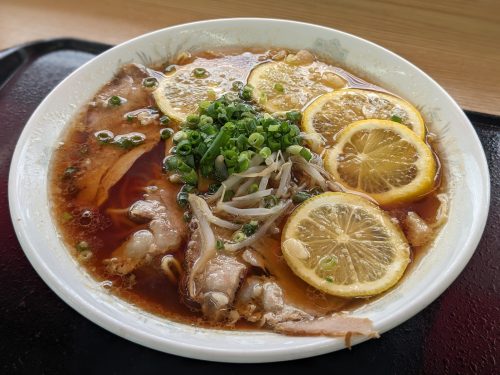
I bought a lemon ramen ticket from a vending machine, gave it to the lady working in the kitchen, then sat myself at a counter and stared out the window as I waited on my food. My ramen was ready in a matter of minutes, and it was probably due to my appetite that I finished my noodles sooner than I would have liked. It was your typical bowl of ramen with pork slices, green onions, and bean sprouts, but the clincher was in the broth that I drank after finishing most of the solid food. Thanks to the zesty lemon juice infiltrating the soup, downing the salty, fatty broth was less of an ordeal as usual.
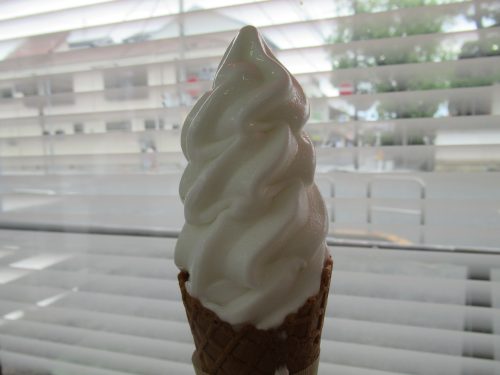
Sayo also sells soft serve ice cream, and though it may look ordinary, what drew me in was the Setouchi lemon flavor that can be found in few other places, even within lemony Hiroshima Prefecture. Customers are supposed to buy ice cream cones from a separate order window outside the store and eat them on the go, but the lady who sold me a cone invited me back into the restaurant to eat while seated. As I was so hungry that even the lemon ramen couldn’t sate my belly, I also devoured this delectable, dairy dessert in a flash.
Moment of Joy: Friendly Neighborhood Shopkeep
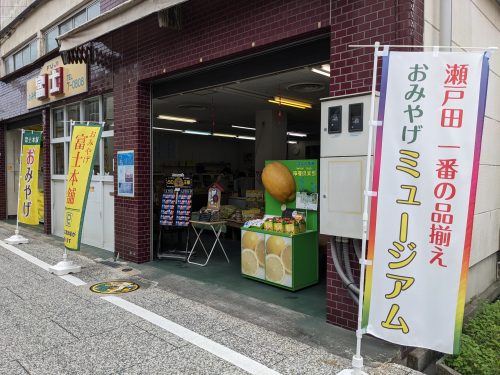
After finishing my food, I decided to wander listlessly around Setoda Port, starting with the shops on Shiomachi. Before entering any gift shops, I was greeted by a friendly woman in front of a building, and no, she wasn’t trying to sell me anything or coax me into any establishment. She was interested in nothing but idle banter, asking me where I came from, if I was biking the Shimanami Kaido, and even whether I was a student (my face and body frame belie my actual age). I was pleasantly surprised by these sudden manners, and for a brief moment I felt like I was not a customer talking to a shopkeeper, but rather a resident chatting up my next-door neighbor. The interaction brightened up my shopping experience and made me want to buy citrus souvenirs all the more.
Drifting around the Port
After I had enough of browsing Hiroshimarian souvenirs, I roamed back to the coast where I first got off the boat to check out the serene, maritime scenery. As I was strolling down the waterside street, I still got warm greetings from workers inside and in front of their stores, and I had to suppress the urge to enter for a second lunch. It was a lazy Monday in the middle of people’s Obon holiday, no one was in a hurry, and when I gazed over at Koneshima on the other side, I could see children playing in front of their houses, free from the shackles of schoolwork and tight schedules. Sometimes vacation isn’t about trying to knock out as many sites as one can; once in a while, I feel the need to drift around a sleepy, seaside town, with empty relaxation as the primary objective.
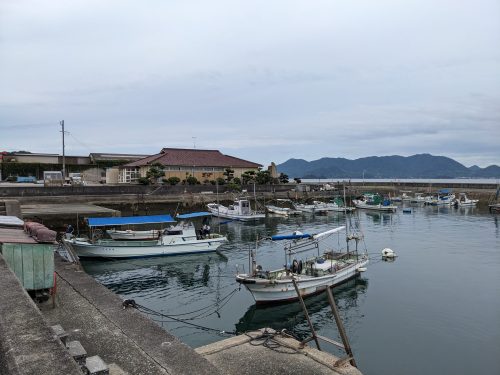
Back inland, there was also plenty to see that didn’t require an admission fee or a significant amount of time. Right off of Shiomachi, close to where the local woman chatted me up, was a staircase leading up to a temple called Hozenji. There wasn’t much to see besides the luscious greenery out in front, but the short climb up the stairs serves as some good post-meal exercise. There are many other temples in the Setoda area, but I figured one was enough, and I was ready to move on.
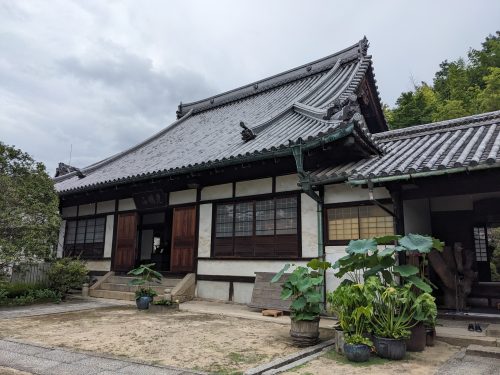
Mukoda Detour
Since there wasn’t enough time to see another museum but I wasn’t yet ready to head home, I decided to take one more ferry trip using two tickets on my excursion ticket set. This line departs from Sawa Port, about a 16-minute walk from Shiomachi, and calls at Mukoda Port in southern Sagishima as well as Sunami Port on mainland Mihara. I made haste to catch the next ferry, but I was unfamiliar with the streets on Ikuchijima, and in the midst of my confusion, ended up missing that ferry by the time I reached Sawa Port. It would be a long wait before the next ferry service, but luck was on my side as the nearby shops were closed, but their tables and chairs were still set outside and unoccupied. During that time, I witnessed the Sea Spica—a fancy, high-speed tourist ferry that runs between Hiroshima’s Ujina Port and Mihara Port—pass me by; that might have been the most eventful thing to happen until my ferry finally showed up.
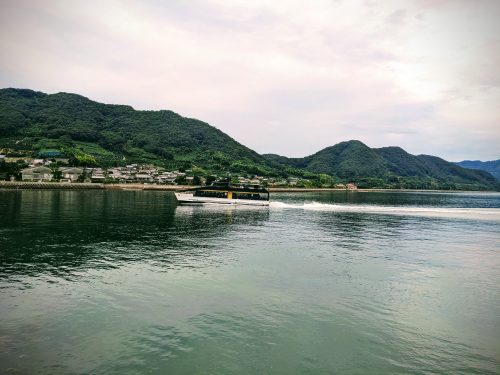
Eventually, I made it onto my boat, a larger, much slower vessel bound for Mihara’s quieter ports. After having a grand time around Sagishima’s Sagi Port, I was curious as to the sites around Mukoda Port, and as I expected, there was even less to see. Right after alighting, tourists can make out a Jizo statue at the water’s edge. This sculpture gives off Miyajima vibes as the base is partially submerged when the tide is high. However, extra care should be taken when photographing this site as the surrounding stones are uneven and slippery, and there are numerous arthropods dwelling within the cracks.
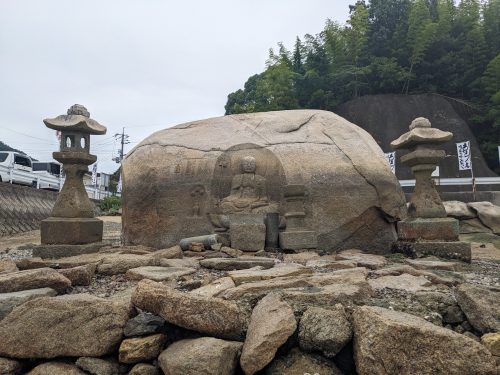
Besides this wonder, Mukoda was basically just tranquil, insular countryside, full of people’s houses and farms. If I had caught the ferry I meant to catch, I would have wandered further from the port to see additional shrines and monuments, but the sun was on its way down and I would have to return to Mihara for dinner. Maybe next time, when it’s cooler, I’ll borrow the bicycle from Café Chitoku and see about pedaling all the way down here.
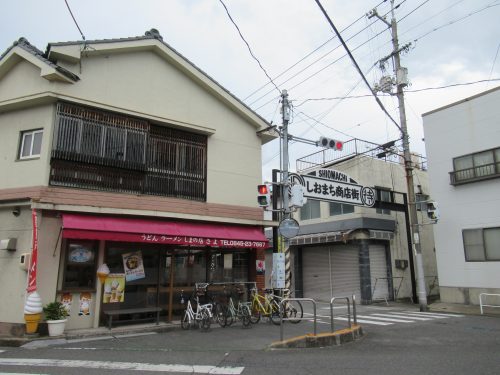
No matter how one gets to Setoda, be it by bike, boat, or bus, the journey is worth it. Those who wish to bike only part of the Shimanami Kaido can opt to rent a bicycle after landing at Setoda and huff on over to Imabari, or conversely, bike here from Onomichi and return the bicycle before sailing back. One thing that’s certain is that a stroll down Shiomachi and a pit stop at a museum or temple is not to be overlooked, as Setoda Port is a place where all travelers are meant to slow down and enjoy life until their second wind comes along. As my maritime Mihara holiday begins drawing to a close, the second wind I received after my outing at Setoda is just what I needed to tackle my final day trip the next day, on an island most sought after by tourists right after Miyajima.
To be continued…
Written by the Joy in Hiroshima Team
